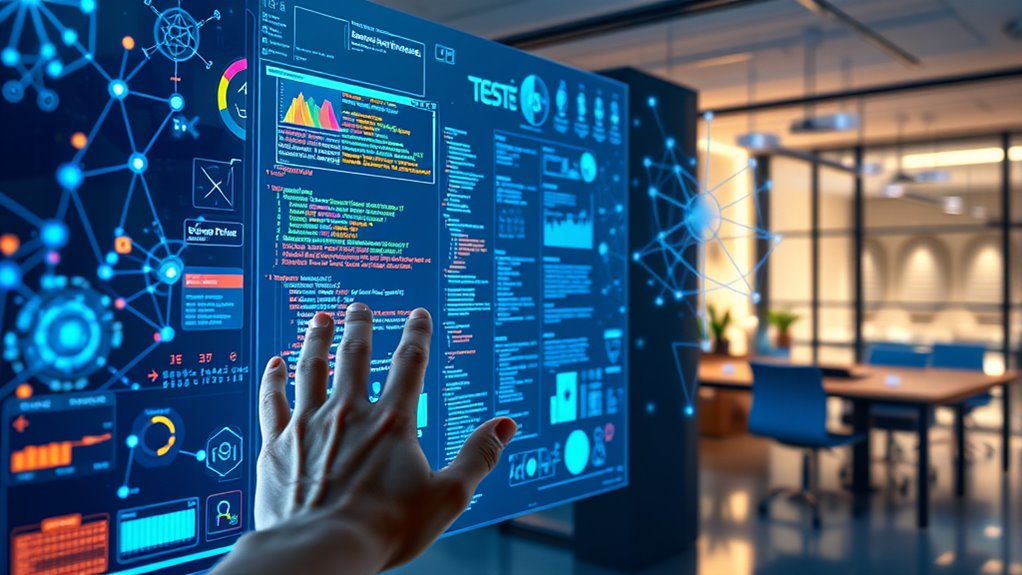In the age of AI, exploratory testing becomes more powerful as you combine human intuition with machine automation. AI helps you automate repetitive tasks, analyze large data sets, and identify anomalies, allowing you to focus on exploring complex behaviors and edge cases. This collaboration enhances your testing coverage, speeds up discovery, and improves documentation. Embracing AI as your partner can transform your approach—continue exploring to uncover how this synergy elevates your testing process.
Key Takeaways
- AI automates repetitive tasks and analyzes data to identify patterns, enhancing the efficiency of exploratory testing.
- Human intuition guides testers to uncover subtle issues AI may overlook, fostering a complementary collaboration.
- Augmented exploratory testing combines AI insights with human judgment for targeted, thorough software exploration.
- AI tools track testing coverage, suggest new test ideas, and document activities, improving overall testing effectiveness.
- Embracing AI as a partner enables testers to focus on creative and complex issues, optimizing bug detection and quality.

As artificial intelligence transforms software testing, exploratory testing remains a fundamental approach for uncovering issues that automated tools might overlook. While AI integration has enhanced many testing processes, it doesn’t replace the value of human intuition. Instead, it complements it, creating a more dynamic and effective testing environment. You can leverage AI to automate repetitive tasks, analyze large data sets, and identify patterns that might escape manual review. However, the real strength of exploratory testing lies in your ability to adapt, think creatively, and pursue unexpected issues based on instinct and experience. Combining AI with your intuition allows you to navigate complex application behaviors, edge cases, and user scenarios that aren’t always predictable or scripted.
AI enhances exploratory testing by automating tasks and analyzing data, but human intuition remains key to uncovering unexpected issues.
In this augmented approach, you begin by using AI tools to gather initial insights—running automated scans, executing test scripts, or analyzing logs—freeing you from mundane tasks. This enables you to focus your attention on areas where human judgment makes the difference. For example, you might notice subtle UI inconsistencies or feel that a certain feature behaves unexpectedly, prompting you to dig deeper. The integration of AI doesn’t diminish your role; it amplifies your capacity to explore software from different angles. As you interact with the application, your intuition guides you toward potential problem spots, while AI provides real-time data, suggested test paths, or anomaly detection, making your exploration more targeted.
Furthermore, AI can assist in documenting your testing sessions, capturing your thought process, and even suggesting new test ideas based on previous findings. This synergy ensures that your exploratory efforts are both efficient and thorough. You’re empowered to follow hunches that, without AI, might have been dismissed as too time-consuming or uncertain. AI integration also helps track your testing coverage, identifying gaps and ensuring you don’t miss critical scenarios. Additionally, understanding concepts like water safety can help inform your testing strategies, especially when considering environmental factors that could impact software performance or user safety. This collaborative approach combines the best of human insight with machine precision, giving you a richer understanding of the software’s behavior.
Ultimately, your ability to adapt in this new landscape depends on embracing AI as a partner, not a replacement. Your intuition remains essential—guiding your exploration, questioning assumptions, and uncovering issues that no automation alone could find. The combination of AI integration and human intuition creates a powerful, augmented exploratory testing process that enhances software quality, accelerates discovery, and ensures that no bug slips through unnoticed. It’s about working smarter, not harder, and making your testing more insightful, efficient, and impactful.
Frequently Asked Questions
How Does AI Improve the Efficiency of Exploratory Testing?
AI improves the efficiency of exploratory testing by automating repetitive tasks and enhancing test coverage through test automation. It analyzes vast amounts of data quickly, helping you identify patterns and potential issues faster. This allows you to focus more on creative, critical thinking while AI handles data analysis and routine testing, making your testing process more effective and efficient. You get faster insights and better defect detection with less manual effort.
What Are the Limitations of Ai-Assisted Exploratory Testing?
AI-assisted exploratory testing has limitations you should be aware of. Bias concerns can skew results if the AI relies on biased data, leading to missed issues. Data dependency means you’re only as good as the data fed into the system; incomplete or poor-quality data limits AI’s effectiveness. You might also face challenges in understanding nuanced user behaviors or creative testing scenarios, which AI currently struggles to replicate fully.
How Can Testers Ensure AI Tools Do Not Overlook Critical Defects?
Your testing efforts can’t risk missing critical defects, no matter how advanced AI tools become. To guarantee this, you must maintain diligent AI oversight, constantly reviewing its suggestions and outputs. Don’t rely solely on AI for defect detection; supplement it with manual testing and critical thinking. By actively monitoring AI performance, you prevent the risk of overlooking essential flaws, much like a lighthouse guiding ships safely through treacherous waters.
What Skills Are Necessary for Testers in Ai-Augmented Environments?
In AI-augmented environments, you need strong testers’ adaptability to navigate evolving tools and workflows. Develop your critical thinking and technical skills to effectively interpret AI outputs and identify gaps. Additionally, prioritize ethical considerations by understanding data privacy, bias, and transparency issues. Staying curious, flexible, and ethically aware guarantees you can leverage AI tools effectively while maintaining rigorous testing standards and safeguarding user interests.
How Does AI Impact the Creativity Aspect of Exploratory Testing?
AI enhances the creativity of your exploratory testing by providing diverse data insights and automating routine tasks, freeing you to focus on innovative approaches. However, you must balance this with AI ethics, ensuring responsible use, and rely on your human intuition to recognize subtle issues AI might miss. This synergy boosts your ability to think outside the box, making your testing more effective and creative.
Conclusion
As you embrace AI, exploratory testing becomes your compass through uncharted software landscapes. AI acts like a seasoned guide, illuminating hidden bugs and unexpected behaviors, turning testing into a dynamic adventure. By combining your intuition with AI’s prowess, you’re not just finding flaws—you’re uncovering opportunities for innovation. Together, you and AI forge a path where testing is less of a chore and more of a thrilling voyage into the future of quality assurance.








